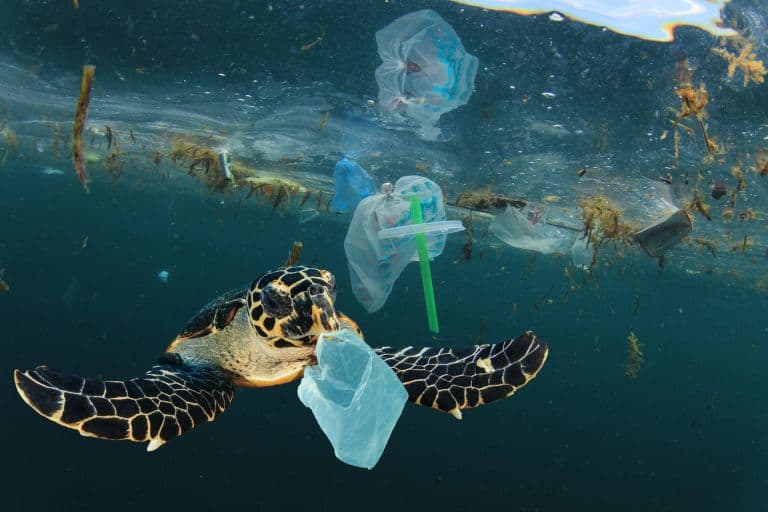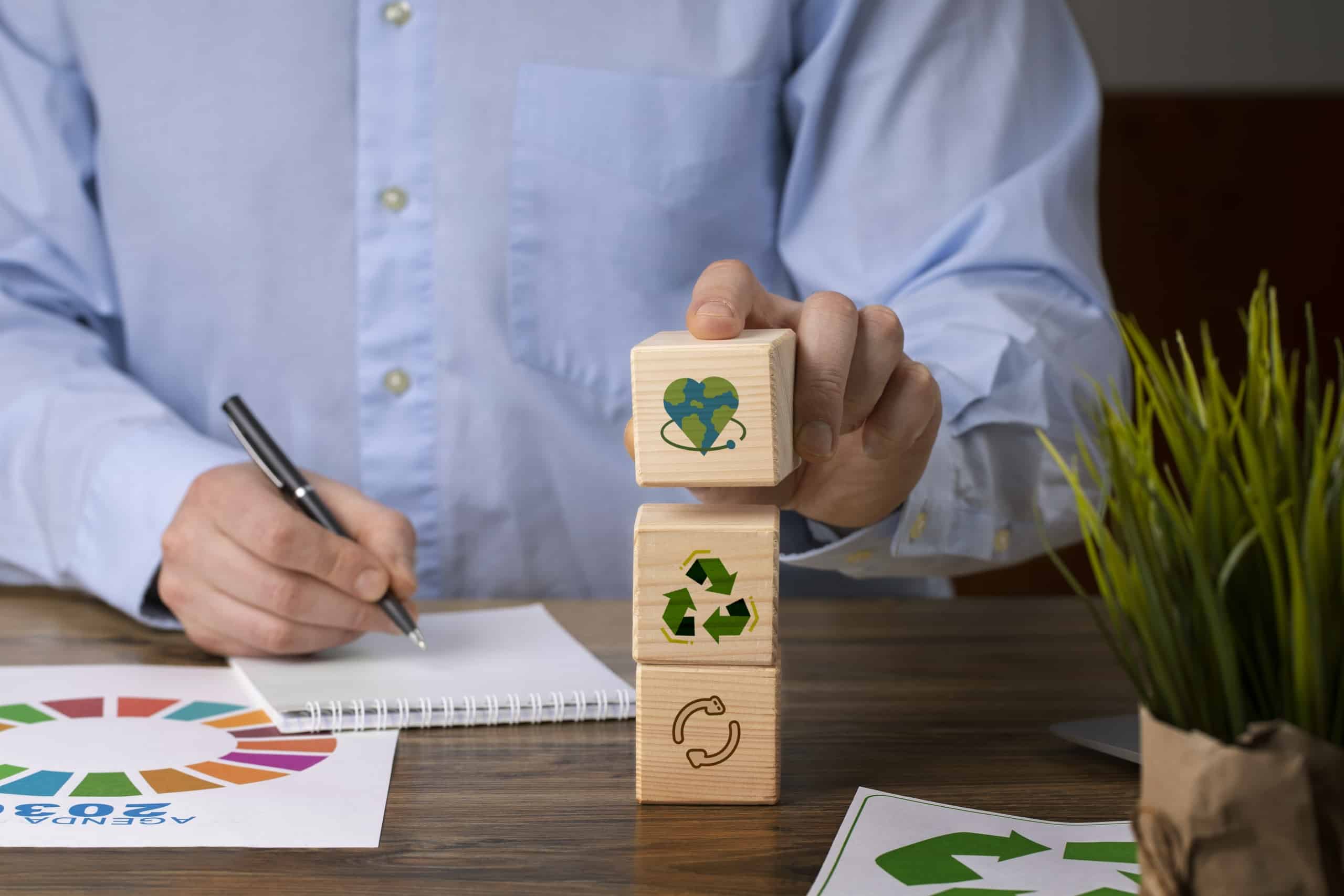The Environmental Impact of Traditional Wet Wipes
Conventional wet wipes are essential for daily hygiene and cleaning routines, although they have a substantial and varied environmental footprint.
- Non-Biodegradable Materials: Non-biodegradable materials, like many conventional wet wipes, are composed of non-woven fabrics containing synthetic fibers like polyester or polypropylene. These compounds are essentially non-biodegradable polymers. When discarded in landfills, these items can endure for as long as 100 years, leading to the accumulation of persistent waste.
- Sewage Blockages: One typical cause of sewage blockages is the improper disposal of wet wipes by flushing them down the toilet. Although some products are advertised as “flushable,” the majority do not break down like toilet paper. Instead, they stay whole and catch on rough surfaces in the sewage system, slowly building up and mixing with fats, oils, and other debris to create big, solid masses called ‘fatbergs’. These obstructions incur high costs and require a substantial amount of labor for towns to eliminate. They can result in substantial sewage overflows, impacting both infrastructure and nearby aquatic bodies.
- Chemical Pollution: Wet wipes are frequently infused with chemicals for cleaning or antibacterial functions. Disposing of these wipes might result in the chemicals seeping into the environment, causing soil and water pollution. Chemical runoff can harm wildlife and ecosystems, especially aquatic organisms that are sensitive to alterations in water chemistry.
- Resource-Intensive Production: Traditional wet wipes production is resource-intensive, demanding substantial quantities of water and electricity. This not only impacts their environmental footprint through raw material extraction but also through greenhouse gas emissions from manufacturing and transportation.
- Impact on Wildlife: Animals, especially marine organisms, may confuse non-biodegradable wet wipes for food. Consuming these substances might cause obstructions in their digestive tracts, potentially resulting in death. Furthermore, when the wipes degrade into tiny plastic particles, they add to the increasing issue of microplastics in the oceans worldwide.
The combined impact of these problems poses a significant environmental burden. As awareness of these issues increases, consumers and producers are encouraged to explore alternatives that reduce environmental damage while maintaining the convenience and cleanliness advantages of wet wipes.
Innovations in Biodegradable Wet Wipes Manufacturing
The emphasis on sustainability in consumer goods has driven notable advancements in the production of biodegradable wet wipes. The advancements aim to minimize the ecological footprint of the items while ensuring their convenience and efficacy. Examining important breakthroughs that are transforming the manufacturing of biodegradable wet wipes.
- Natural Fiber Use: Transitioning from synthetic materials to natural fibers represents a significant shift in material usage. Bamboo, cotton, and wood pulp cellulose fibers are becoming popular options. Bamboo is highly renewable because of its fast growth rate and possesses natural antibacterial characteristics, making it an ideal material for hygiene products. The fibers are sustainable, totally biodegradable, and compostable under specific conditions.
- Biodegradable Polymers: Biodegradable polymers are being utilized by some producers to address the demand for materials that decompose at a faster rate. The polymers are designed to break down quickly when exposed to natural environmental conditions. PLA, a bioplastic made from corn starch, provides a straightforward path to decomposition without producing toxic byproducts.
- Water-Soluble Formulations: Water-soluble formulations are being developed to create wet wipes that can dissolve completely in water. Water-soluble wipes are usually composed of ingredients such as PVA (polyvinyl alcohol) that dissolve in water, preventing obstructions in sewage systems.
- Advanced Composting Technologies: Advanced composting technologies refer to biodegradable wipes that are specifically engineered to break down in industrial or residential compost environments within a given timeframe. This method aids in trash management and also generates beneficial compost for agricultural and landscaping purposes.
- Decreased Chemical Content: Wet wipes manufacturers are prioritizing the reduction of chemical usage in wet wipes. Choosing natural and less hazardous ingredients for cleaning and antibacterial purposes makes the wipes safer for the environment and human health. Substitutes such as aloe vera, witch hazel, and essential oils are replacing harsh chemicals in products.
- Eco-friendly Packaging: Eco-friendly packaging is crucial in addition to the product itself. Businesses are creating packaging that is recyclable or biodegradable to enhance the environmental advantages of the wipes contained within. Recycled paper, bioplastics, and plant-based films are used to make the entire product sustainable.
The breakthroughs combine material science, chemical engineering, and ecological consciousness to develop goods that are useful and eco-friendly. The advancement of technology and materials offers exciting opportunities to decrease the environmental impact of wet wipes, leading to a more sustainable approach in the personal care and cleaning product sectors.
Sustainable Manufacturing Practices
Implementing sustainable production processes in the wet wipes business is crucial for minimizing the products’ environmental footprint. Companies are implementing many techniques to make their operations more environmentally friendly in order to comply with global sustainability objectives.
- Energy Efficiency: Energy efficiency is being improved by numerous wet wipes manufacturers through facility upgrades aimed at decreasing energy use. This involves utilizing energy-efficient equipment and refining industrial procedures to reduce energy consumption. Implementing LED lighting, high-efficiency HVAC systems, and motion sensors to regulate energy consumption in inactive areas also makes a substantial contribution.
- Renewable Energy Transition: Certain wet wipes manufacturers are shifting to renewable energy sources to fuel their activities. Common options include utilizing solar panels, and wind turbines, or buying renewable energy credits. This not only aids in decreasing carbon emissions but can also leads to reduced long-term energy expenses.
- Water Conservation: The creation of wet wipes involves significant water consumption, especially in the fabrication of non-woven materials. Integrating water recycling systems in the plant enables the reuse of treated water in the production process. Advanced filtration and treatment methods guarantee that the water is sufficiently pure for recycling, leading to a substantial decrease in total water usage.
- Reducing Waste: Minimizing the amount of trash produced is a crucial element of sustainable manufacturing. This entails maximizing resource utilization and enhancing production methods to minimize waste generation. Moreover, firms are increasingly engaging in recycling programs to efficiently manage waste, ensuring that production by-products are either reused or recycled.
- Sustainable Sourcing: Sustainable sourcing is essential for sustainability as it involves obtaining raw materials in an environmentally friendly and ethical manner. Wet wipes manufacturers are choosing environmentally sourced raw materials like certified organic cotton or bamboo from managed forests. These procedures ensure that the resources are renewable and that their cultivation does not cause deforestation or affect local ecosystems.
- Cleaner Production Techniques: To reduce the chemical load in wet wipes, cleaner production techniques involve using less hazardous compounds, including more natural alternatives, and utilizing innovative technologies to treat and recycle chemicals used in the production process. Implementing cleaner production procedures decreases the risk of contamination and enhances worker safety.
- Green Logistics: Green Logistics involves sustainable practices in manufacturing, as well as in the areas of logistics and distribution. Businesses are enhancing their supply chains to minimize transportation distances and emissions. Utilizing electric or hybrid cars for distributing products and optimizing route planning to reduce travel lengths helps decrease carbon emissions.
- Lifecycle Assessment: Companies are increasingly performing lifecycle evaluations (LCAs) of their products to ensure comprehensive sustainability. The assessments analyze the environmental impact of a product from the extraction of raw materials to manufacturing, usage, and disposal. LCAs provide valuable information for organizations to pinpoint areas for enhancement and create plans to reduce environmental effects across the whole lifespan of a product.
Sustainable manufacturing strategies assist wet wipes manufacturers in minimizing their environmental footprint and enhancing their competitiveness in a market that prioritizes eco-friendly products. Wet wipes manufacturers can make a substantial contribution to environmental conservation and meet consumer demand for sustainable products by implementing these strategies.
Challenges and Future Prospects
Transitioning to more sustainable processes in the wet wipes sector has benefits but also comes with obstacles. Yet, these obstacles are accompanied by encouraging opportunities that have the potential to revolutionize the sector even further.
Obstacles
- Cost Implications: Transitioning to biodegradable materials and adopting sustainable production practices typically result in increased expenses. Natural materials like organic cotton or bamboo and innovative biodegradable polymers may cost more than typical non-biodegradable fabrics. These expenses may be transferred to consumers, which could reduce the competitiveness of sustainable wet wipes in markets where price is a significant factor.
- Consumer Behavior: The evolving consumer behavior presents a substantial issue. Most consumers are familiar with the convenience and affordability of regular wet wipes. Education on the environmental effects of non-biodegradable wipes and the advantages of selecting biodegradable options is necessary. This can involve extensive marketing and awareness initiatives.
- Regulatory Hurdles: Regulatory obstacles arise due to the absence of uniform standards for defining “biodegradable,” causing consumer misunderstanding and variations in product quality. Establishing and implementing precise regulations that outline biodegradability criteria and guarantee product adherence is crucial yet difficult.
- Technological Limitations: Technological limitations persist despite advancements in biodegradable materials and production techniques, necessitating additional research and development. Biodegradable wipes need to have the same strength and moisture retention as standard wipes to satisfy consumer expectations.
- Supply Chain Adjustments: Transitioning to sustainable raw materials necessitates modifications across the whole supply chain, encompassing sourcing, production, and distribution. Coordinating these adjustments, assuring the availability of sustainable resources, and managing the logistics can be intricate and time-consuming.
Future Opportunities
- Advanced Material Research: Ongoing research is being conducted on new biodegradable materials and composites to enhance the performance of eco-friendly wet wipes while reducing prices. Advancements in materials science may result in the creation of high-quality biodegradable polymers that provide equivalent functionality to conventional materials at a competitive cost.
- Regulatory Support: With increasing knowledge of environmental concerns, governments are more inclined to introduce favorable laws and regulations. Possible measures could involve providing subsidies for sustainable activities, offering financial incentives for the use of biodegradable materials, or implementing stricter rules on non-biodegradable items to provide a fair competition environment.
- Market Opportunities: New market opportunities arise for wet wipes manufacturers that prioritize environmental responsibility due to the growing customer demand for sustainable products. This trend has the potential to stimulate growth in the industry and motivate more enterprises to develop innovative and invest in sustainable solutions.
- Technological Innovations: Technological advancements can improve production processes, making manufacturing more efficient and reducing waste and energy usage. Moreover, advancements in recycling technology could enhance the feasibility of material reuse, hence decreasing the environmental impact.
- Global Collaboration: Cooperation among enterprises, governments, and non-governmental organizations (NGOs) can result in joint projects and solutions to tackle the issues of sustainable manufacturing. These collaborations can stimulate creativity, simplify regulatory procedures, and encourage the worldwide implementation of superior methods.
Overall, although facing substantial obstacles, the future of producing sustainable wet wipes has great potential. The industry can effectively address environmental issues and meet the increasing customer demand for green products by continuously innovating and adapting.





